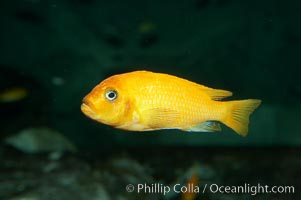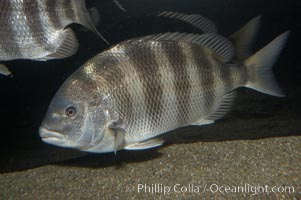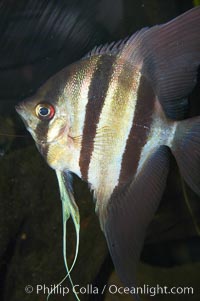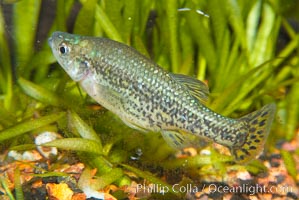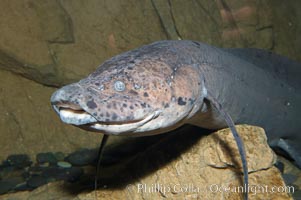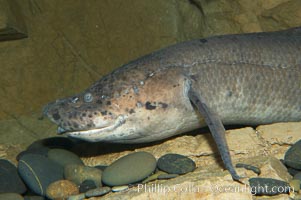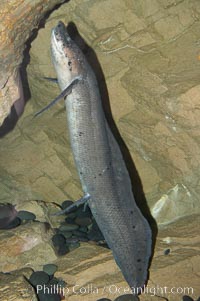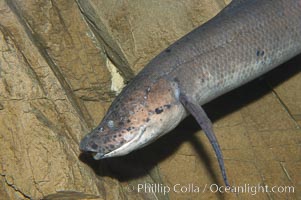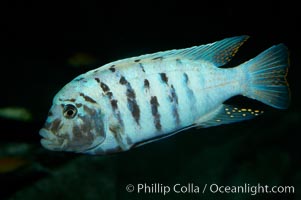
Unidentified cichlid fish.
Image ID: 11023
Image ID: 11023
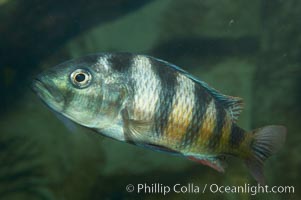
Unidentified cichlid fish.
Image ID: 11044
Image ID: 11044
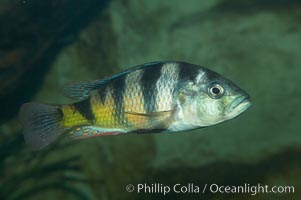
Unidentified cichlid fish.
Image ID: 11045
Image ID: 11045
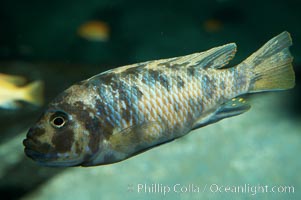
Unidentified cichlid fish.
Image ID: 11047
Image ID: 11047
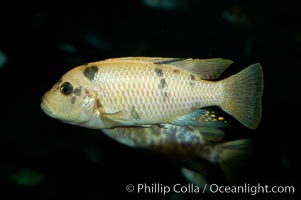
Unidentified cichlid fish.
Image ID: 11048
Image ID: 11048
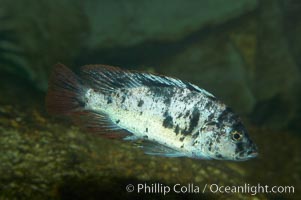
Unidentified cichlid fish.
Image ID: 11049
Image ID: 11049
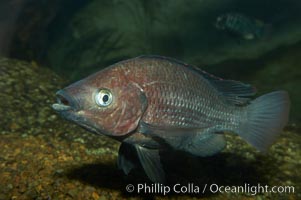
Unidentified cichlid fish.
Image ID: 11050
Image ID: 11050
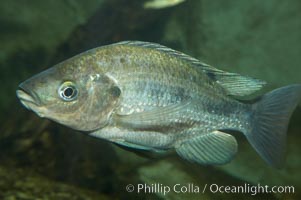
Unidentified cichlid fish.
Image ID: 11051
Image ID: 11051
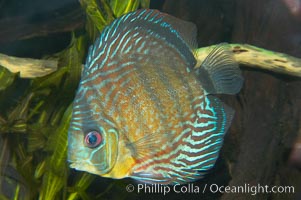
Wild discus. The female wild discuss will lay several hundred eggs and guard them until they hatch. Once they emerge, the young fish attach themselves to the sides of their parents for the first few weeks of their lives, feeding on a milky secretion produced by glands in the parents flanks.
Species: Wild discus, Symphysodon discus
Image ID: 13953
Species: Wild discus, Symphysodon discus
Image ID: 13953
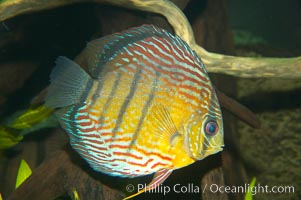
Wild discus. The female wild discuss will lay several hundred eggs and guard them until they hatch. Once they emerge, the young fish attach themselves to the sides of their parents for the first few weeks of their lives, feeding on a milky secretion produced by glands in the parents flanks.
Species: Wild discus, Symphysodon discus
Image ID: 13954
Species: Wild discus, Symphysodon discus
Image ID: 13954
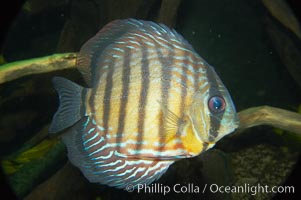
Wild discus. The female wild discuss will lay several hundred eggs and guard them until they hatch. Once they emerge, the young fish attach themselves to the sides of their parents for the first few weeks of their lives, feeding on a milky secretion produced by glands in the parents flanks.
Species: Wild discus, Symphysodon discus
Image ID: 13955
Species: Wild discus, Symphysodon discus
Image ID: 13955
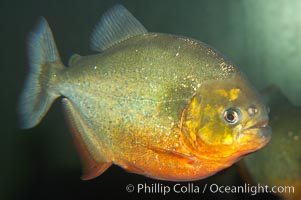
Red-bellied piranha. The piranhas teeth are so sharp that Amazonian Indians use them as knives. Each tooth has sawlike edges that allow the fish to slice through prey. The teeth are continually replaced throughout the piranhas life. Piranhas are illegal to import, sell or own in California.
Species: Red piranha, Pygocentrus nattereri
Image ID: 13956
Species: Red piranha, Pygocentrus nattereri
Image ID: 13956
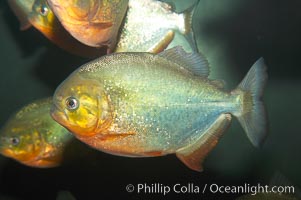
Red-bellied piranha. The piranhas teeth are so sharp that Amazonian Indians use them as knives. Each tooth has sawlike edges that allow the fish to slice through prey. The teeth are continually replaced throughout the piranhas life. Piranhas are illegal to import, sell or own in California.
Species: Red piranha, Pygocentrus nattereri
Image ID: 13957
Species: Red piranha, Pygocentrus nattereri
Image ID: 13957
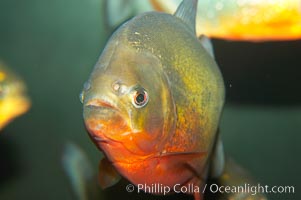
Red-bellied piranha. The piranhas teeth are so sharp that Amazonian Indians use them as knives. Each tooth has sawlike edges that allow the fish to slice through prey. The teeth are continually replaced throughout the piranhas life. Piranhas are illegal to import, sell or own in California.
Species: Red piranha, Pygocentrus nattereri
Image ID: 13958
Species: Red piranha, Pygocentrus nattereri
Image ID: 13958
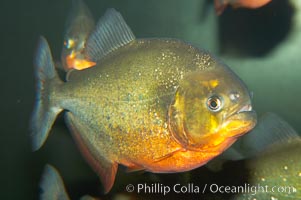
Red-bellied piranha. The piranhas teeth are so sharp that Amazonian Indians use them as knives. Each tooth has sawlike edges that allow the fish to slice through prey. The teeth are continually replaced throughout the piranhas life. Piranhas are illegal to import, sell or own in California.
Species: Red piranha, Pygocentrus nattereri
Image ID: 13959
Species: Red piranha, Pygocentrus nattereri
Image ID: 13959
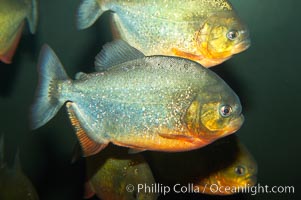
Red-bellied piranha. The piranhas teeth are so sharp that Amazonian Indians use them as knives. Each tooth has sawlike edges that allow the fish to slice through prey. The teeth are continually replaced throughout the piranhas life. Piranhas are illegal to import, sell or own in California.
Species: Red piranha, Pygocentrus nattereri
Image ID: 13960
Species: Red piranha, Pygocentrus nattereri
Image ID: 13960
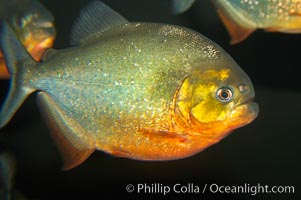
Red-bellied piranha. The piranhas teeth are so sharp that Amazonian Indians use them as knives. Each tooth has sawlike edges that allow the fish to slice through prey. The teeth are continually replaced throughout the piranhas life. Piranhas are illegal to import, sell or own in California.
Species: Red piranha, Pygocentrus nattereri
Image ID: 13961
Species: Red piranha, Pygocentrus nattereri
Image ID: 13961
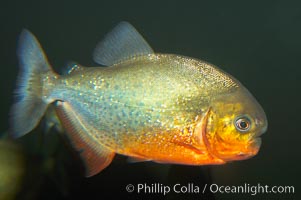
Red-bellied piranha. The piranhas teeth are so sharp that Amazonian Indians use them as knives. Each tooth has sawlike edges that allow the fish to slice through prey. The teeth are continually replaced throughout the piranhas life. Piranhas are illegal to import, sell or own in California.
Species: Red piranha, Pygocentrus nattereri
Image ID: 13962
Species: Red piranha, Pygocentrus nattereri
Image ID: 13962
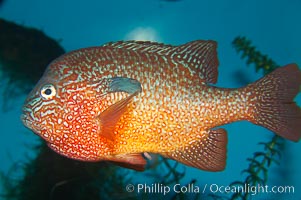
Longear sunfish. Male longear sunfishes, which are larger and more colorful than the females, build nests, using their tails to carve pits out of gravel where the females can lay their eggs. The males then guard the nest until the eggs have hatched and the young fish are large enough to leave.
Species: Longear sunfish, Lepomis megalotis
Image ID: 13963
Species: Longear sunfish, Lepomis megalotis
Image ID: 13963
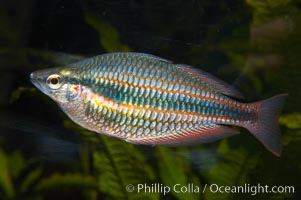
Banded rainbowfish. The banded rainbowfish, from the Goyder River in Australias Northwest Territory, is evolving into a separate species (from other rainbowfishes), has assumed a narrow range and has developed a unique coloration.
Species: Banded rainbowfish, Melanotaenia trifasciata
Image ID: 13964
Species: Banded rainbowfish, Melanotaenia trifasciata
Image ID: 13964

Electric eel. Like other members of the South American knifefish family, the electric eel relies on electrolocation to navigate in find food in murky water. However, its electric organs are more powerful than its relatives, allowing it to produce sufficiently high voltage pulses to stun predators and prey.
Species: Electric eel, Electrophorus electricus
Image ID: 13989
Species: Electric eel, Electrophorus electricus
Image ID: 13989
